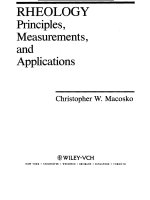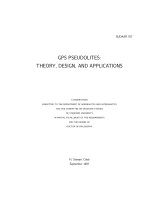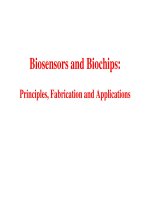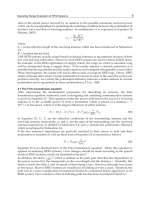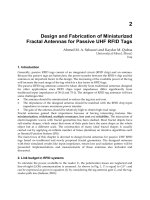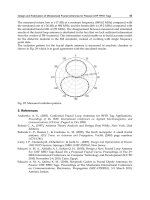Coordination chemistry in protein cages principles design and applications
Bạn đang xem bản rút gọn của tài liệu. Xem và tải ngay bản đầy đủ của tài liệu tại đây (7.42 MB, 405 trang )
COORDINATION
CHEMISTRY IN
PROTEIN CAGES
COORDINATION
CHEMISTRY IN
PROTEIN CAGES
Principles, Design, and Applications
Edited by
TAKAFUMI UENO
YOSHIHITO WATANABE
Copyright
C
2013 by John Wiley & Sons, Inc. All rights reserved.
Published by John Wiley & Sons, Inc., Hoboken, New Jersey
Published simultaneously in Canada
No part of this publication may be reproduced, stored in a retrieval system, or transmitted in any form or
by any means, electronic, mechanical, photocopying, recording, scanning, or otherwise, except as
permitted under Section 107 or 108 of the 1976 United States Copyright Act, without either the prior
written permission of the Publisher, or authorization through payment of the appropriate per-copy fee to
the Copyright Clearance Center, Inc., 222 Rosewood Drive, Danvers, MA 01923, (978) 750-8400,
fax (978) 750-4470, or on the web at www.copyright.com. Requests to the Publisher for permission
should be addressed to the Permissions Department, John Wiley & Sons, Inc., 111 River Street, Hoboken,
NJ 07030, (201) 748-6011, fax (201) 748-6008, or online at />Limit of Liability/Disclaimer of Warranty: While the publisher and author have used their best efforts in
preparing this book, they make no representations or warranties with respect to the accuracy or
completeness of the contents of this book and specifically disclaim any implied warranties of
merchantability or fitness for a particular purpose. No warranty may be created or extended by sales
representatives or written sales materials. The advice and strategies contained herein may not be suitable
for your situation. You should consult with a professional where appropriate. Neither the publisher nor
author shall be liable for any loss of profit or any other commercial damages, including but not limited to
special, incidental, consequential, or other damages.
For general information on our other products and services or for technical support, please contact our
Customer Care Department within the United States at (800) 762-2974, outside the United States
at (317) 572-3993 or fax (317) 572-4002.
Wiley also publishes its books in a variety of electronic formats. Some content that appears in print may
not be available in electronic formats. For more information about Wiley products, visit our web site at
www.wiley.com.
Library of Congress Cataloging-in-Publication Data:
Coordination chemistry in protein cages principles, design, and applications / edited by Takafumi Ueno,
Yoshihito Watanabe.
pages cm
Includes index.
ISBN 978-1-118-07857-0 (cloth)
1. Protein drugs. 2. Protein drugs–Physiological transport. 3. Carrier proteins. I. Ueno, Takafumi,
1971– editor of compilation. II. Watanabe, Yoshihito, editor of compilation.
RS431.P75C66 2013
615.1 9–dc23
2012045122
Printed in the United States of America
ISBN: 9781118078570
10 9 8 7 6 5 4 3 2 1
CONTENTS
Foreword
Preface
Contributors
xiii
xv
xvii
PART I COORDINATION CHEMISTRY IN NATIVE
PROTEIN CAGES
1 The Chemistry of Nature’s Iron Biominerals in Ferritin Protein
Nanocages
3
Elizabeth C. Theil and Rabindra K. Behera
1.1 Introduction
1.2 Ferritin Ion Channels and Ion Entry
1.2.1 Maxi- and Mini-Ferritin
1.2.2 Iron Entry
1.3 Ferritin Catalysis
1.3.1 Spectroscopic Characterization of -1,2 Peroxodiferric
Intermediate (DFP)
1.3.2 Kinetics of DFP Formation and Decay
1.4 Protein-Based Ferritin Mineral Nucleation and Mineral Growth
1.5 Iron Exit
1.6 Synthetic Uses of Ferritin Protein Nanocages
1.6.1 Nanomaterials Synthesized in Ferritins
3
6
6
7
8
8
12
13
16
17
18
v
vi
CONTENTS
1.6.2
Ferritin Protein Cages in Metalloorganic Catalysis and
Nanoelectronics
1.6.3 Imaging and Drug Delivery Agents Produced in Ferritins
1.7 Summary and Perspectives
Acknowledgments
References
2 Molecular Metal Oxides in Protein Cages/Cavities
19
19
20
20
21
25
Achim M¨uller and Dieter Rehder
2.1 Introduction
2.2 Vanadium: Functional Oligovanadates and Storage of VO2+ in
Vanabins
2.3 Molybdenum and Tungsten: Nucleation Process in a Protein
Cavity
2.4 Manganese in Photosystem II
2.5 Iron: Ferritins, DPS Proteins, Frataxins, and Magnetite
2.6 Some General Remarks: Oxides and Sulfides
References
25
26
28
33
35
38
38
PART II DESIGN OF METALLOPROTEIN CAGES
3 De Novo Design of Protein Cages to Accommodate
Metal Cofactors
45
Flavia Nastri, Rosa Bruni, Ornella Maglio, and Angela Lombardi
3.1 Introduction
3.2 De Novo-Designed Protein Cages Housing Mononuclear
Metal Cofactors
3.3 De Novo-Designed Protein Cages Housing Dinuclear Metal
Cofactors
3.4 De Novo-Designed Protein Cages Housing Heme Cofactor
3.5 Summary and Perspectives
Acknowledgments
References
4 Generation of Functionalized Biomolecules Using Hemoprotein
Matrices with Small Protein Cavities for Incorporation of
Cofactors
45
47
59
66
79
79
80
87
Takashi Hayashi
4.1 Introduction
4.2 Hemoprotein Reconstitution with an Artificial Metal Complex
4.3 Modulation of the O2 Affinity of Myoglobin
87
89
90
CONTENTS
4.4 Conversion of Myoglobin into Peroxidase
4.4.1
Construction of a Substrate-Binding Site Near the
Heme Pocket
4.4.2
Replacement of Native Heme with Iron Porphyrinoid
in Myoglobin
4.4.3
Other Systems Used in Enhancement of Peroxidase
Activity of Myoglobin
4.5 Modulation of Peroxidase Activity of HRP
4.6 Myoglobin Reconstituted with a Schiff Base Metal Complex
4.7 A Reductase Model Using Reconstituted Myoglobin
4.7.1
Hydrogenation Catalyzed by Cobalt Myoglobin
4.7.2
A Model of Hydrogenase Using the Heme Pocket of
Cytochrome c
4.8 Summary and Perspectives
Acknowledgments
References
5 Rational Design of Protein Cages for Alternative
Enzymatic Functions
vii
95
95
99
100
102
103
106
106
107
108
108
108
111
Nicholas M. Marshall, Kyle D. Miner, Tiffany D. Wilson, and Yi Lu
5.1
5.2
5.3
5.4
5.5
5.6
5.7
5.8
5.9
5.10
Introduction
Mononuclear Electron Transfer Cupredoxin Proteins
CuA Proteins
Catalytic Copper Proteins
5.4.1
Type 2 Red Copper Sites
5.4.2
Other T2 Copper Sites
5.4.3
Cu, Zn Superoxide Dismutase
5.4.4
Multicopper Oxygenases and Oxidases
Heme-Based Enzymes
5.5.1
Mb-Based Peroxidase and P450 Mimics
5.5.2
Mimicking Oxidases in Mb
5.5.3
Mimicking NOR Enzymes in Mb
5.5.4
Engineering Peroxidase Proteins
5.5.5
Engineering Cytochrome P450s
Non-Heme ET Proteins
Fe and Mn Superoxide Dismutase
Non-Heme Fe Catalysts
Zinc Proteins
Other Metalloproteins
5.10.1 Cobalt Proteins
5.10.2 Manganese Proteins
5.10.3 Molybdenum Proteins
5.10.4 Nickel Proteins
111
112
116
118
118
120
121
122
124
124
125
127
128
129
131
132
133
134
135
135
136
137
137
viii
CONTENTS
5.10.5 Uranyl Proteins
5.10.6 Vanadium Proteins
5.11 Summary and Perspectives
References
138
138
139
142
PART III COORDINATION CHEMISTRY OF PROTEIN
ASSEMBLY CAGES
6 Metal-Directed and Templated Assembly of Protein
Superstructures and Cages
151
F. Akif Tezcan
6.1 Introduction
6.2 Metal-Directed Protein Self-Assembly
6.2.1 Background
6.2.2 Design Considerations for Metal-Directed Protein
Self-Assembly
6.2.3 Interfacing Non-Natural Chelates with MDPSA
6.2.4 Crystallographic Applications of Metal-Directed
Protein Self-Assembly
6.3 Metal-Templated Interface Redesign
6.3.1 Background
6.3.2 Construction of a Zn-Selective Tetrameric Protein
Complex Through MeTIR
6.3.3 Construction of a Zn-Selective Protein Dimerization
Motif Through MeTIR
6.4 Summary and Perspectives
Acknowledgments
References
7 Catalytic Reactions Promoted in Protein Assembly Cages
151
152
152
153
155
159
162
162
163
166
170
171
171
175
Takafumi Ueno and Satoshi Abe
7.1 Introduction
7.1.1 Incorporation of Metal Compounds
7.1.2 Insight into Accumulation Process of Metal Compounds
7.2 Ferritin as a Platform for Coordination Chemistry
7.3 Catalytic Reactions in Ferritin
7.3.1 Olefin Hydrogenation
7.3.2 Suzuki–Miyaura Coupling Reaction in Protein Cages
7.3.3 Polymer Synthesis in Protein Cages
7.4 Coordination Processes in Ferritin
7.4.1 Accumulation of Metal Ions
7.4.2 Accumulation of Metal Complexes
175
176
177
177
179
179
182
185
188
188
192
CONTENTS
7.5 Coordination Arrangements in Designed Ferritin Cages
7.6 Summary and Perspectives
Acknowledgments
References
8 Metal-Catalyzed Organic Transformations Inside a Protein
Scaffold Using Artificial Metalloenzymes
ix
194
197
198
198
203
V. K. K. Praneeth and Thomas R. Ward
8.1 Introduction
8.2 Enantioselective Reduction Reactions Catalyzed by Artificial
Metalloenzymes
8.2.1
Asymmetric Hydrogenation
8.2.2
Asymmetric Transfer Hydrogenation of Ketones
8.2.3
Artificial Transfer Hydrogenation of Cyclic Imines
8.3 Palladium-Catalyzed Allylic Alkylation
8.4 Oxidation Reaction Catalyzed by Artificial Metalloenzymes
8.4.1
Artificial Sulfoxidase
8.4.2
Asymmetric cis-Dihydroxylation
8.5 Summary and Perspectives
References
PART IV
203
204
204
206
208
211
212
212
215
216
218
APPLICATIONS IN BIOLOGY
9 Selective Labeling and Imaging of Protein Using Metal Complex
223
Yasutaka Kurishita and Itaru Hamachi
9.1 Introduction
9.2 Tag–Probe Pair Method Using Metal-Chelation System
9.2.1
Tetracysteine Motif/Arsenical Compounds Pair
9.2.2
Oligo-Histidine Tag/Ni(ii)-NTA Pair
9.2.3
Oligo-Aspartate Tag/Zn(ii)-DpaTyr Pair
9.2.4
Lanthanide-binding Tag
9.3 Summary and Perspectives
References
10
Molecular Bioengineering of Magnetosomes for Biotechnological
Applications
223
225
225
227
230
235
237
237
241
Atsushi Arakaki, Michiko Nemoto, and Tadashi Matsunaga
10.1 Introduction
10.2 Magnetite Biomineralization Mechanism in Magnetosome
10.2.1 Diversity of Magnetotactic Bacteria
241
242
242
x
CONTENTS
10.2.2
Genome and Proteome Analyses of Magnetotactic
Bacteria
10.2.3 Magnetosome Formation Mechanism
10.2.4 Morphological Control of Magnetite Crystal in
Magnetosomes
10.3 Functional Design of Magnetosomes
10.3.1 Protein Display on Magnetosome by Gene Fusion
Technique
10.3.2 Magnetosome Surface Modification by In Vitro System
10.3.3 Protein-mediated Morphological Control of Magnetite
Particles
10.4 Application
10.4.1 Enzymatic Bioassays
10.4.2 Cell Separation
10.4.3 DNA Extraction
10.4.4 Bioremediation
10.5 Summary and Perspectives
Acknowledgments
References
PART V
11
244
246
250
251
252
255
257
258
259
260
262
264
266
266
266
APPLICATIONS IN NANOTECHNOLOGY
Protein Cage Nanoparticles for Hybrid Inorganic–Organic
Materials
275
Shefah Qazi, Janice Lucon, Masaki Uchida, and Trevor Douglas
11.1 Introduction
11.2 Biomineral Formation in Protein Cage Architectures
11.2.1 Introduction
11.2.2 Mineralization
11.2.3 Model for Synthetic Nucleation-Driven Mineralization
11.2.4 Mineralization in Dps: A 12-Subunit Protein Cage
11.2.5 Icosahedral Protein Cages: Viruses
11.2.6 Nucleation of Inorganic Nanoparticles Within
Icosahedral Viruses
11.3 Polymer Formation Inside Protein Cage Nanoparticles
11.3.1 Introduction
11.3.2 Azide–Alkyne Click Chemistry in sHsp and P22
11.3.3 Atom Transfer Radical Polymerization in P22
11.3.4 Application as Magnetic Resonance Imaging Contrast
Agents
275
277
277
278
279
279
282
282
283
283
285
287
290
CONTENTS
11.4 Coordination Polymers in Protein Cages
11.4.1 Introduction
11.4.2 Metal–Organic Branched Polymer Synthesis
by Preforming Complexes
11.4.3 Coordination Polymer Formation from Ditopic Ligands
and Metal Ions
11.4.4 Altering Protein Dynamics by Coordination:
Hsp-Phen-Fe
11.5 Summary and Perspectives
Acknowledgments
References
12
Nanoparticles Synthesized and Delivered by Protein in the Field of
Nanotechnology Applications
xi
292
292
292
295
296
298
298
298
305
Ichiro Yamashita, Kenji Iwahori, Bin Zheng, and Shinya Kumagai
12.1 Nanoparticle Synthesis in a Bio-Template
12.1.1 NP Synthesis by Cage-Shaped Proteins for
Nanoelectronic Devices and Other Applications
12.1.2 Metal Oxide or Hydro-Oxide NP Synthesis in the
Apoferritin Cavity
12.1.3 Compound Semiconductor NP Synthesis in the
Apoferritin Cavity
12.1.4 NP Synthesis in the Apoferritin with the Metal-Binding
Peptides
12.2 Site-Directed Placement of NPs
12.2.1 Nanopositioning of Cage-Shaped Proteins
12.2.2 Nanopositioning of Au NPs by Porter Proteins
12.3 Fabrication of Nanodevices by the NP and Protein Conjugates
12.3.1 Fabrication of Floating Nanodot Gate Memory
12.3.2 Fabrication of Single-Electron Transistor Using Ferritin
References
13
Engineered “Cages” for Design of Nanostructured
Inorganic Materials
305
305
307
308
311
312
312
313
317
318
321
326
329
Patrick B. Dennis, Joseph M. Slocik, and Rajesh R. Naik
13.1
13.2
13.3
13.4
13.5
13.6
Introduction
Metal-Binding Peptides
Discrete Protein Cages
Heat-Shock Proteins
Polymeric Protein and Carbohydrate Quasi-Cages
Summary and Perspectives
References
329
331
332
334
340
346
347
xii
CONTENTS
PART VI
14
COORDINATION CHEMISTRY INSPIRED BY
PROTEIN CAGES
Metal–Organic Caged Assemblies
353
Sota Sato and Makoto Fujita
14.1 Introduction
14.2 Construction of Polyhedral Skeletons by Coordination Bonds
14.2.1 Geometrical Effect on Products
14.2.2 Structural Extension Based on Rigid, Designable
Framework
14.2.3 Mechanistic Insight into Self-Assembly
14.3 Development of Functions via Chemical Modification
14.3.1 Chemistry in the Hollow of Cages
14.3.2 Chemistry on the Periphery of Cages
14.4 Metal–Organic Cages for Protein Encapsulation
14.5 Summary and Perspectives
References
Index
353
355
356
358
366
366
367
368
370
370
371
375
FOREWORD
The field of biological inorganic chemistry has taken many new directions in the
first part of the 21st century [1]. One area of great current interest deals with the
role of outer sphere interactions in tuning the properties of active sites in metalloproteins. Investigators are building on early ideas of “the entatic state” and “the
rack effect” in interpreting the modulation of active site properties in the cavities of
folded polypeptide structures [2, 3]. Others are designing and constructing synthetic
molecular cavities for studies of host-guest interactions. The cavity in ferritin, the iron
storage protein and the superstar of nanocages, is the subject of the opening chapter
in this timely collection of reviews edited by my good friends Yoshi Watanabe and
Takafumi Ueno. In their review, Theil and Behera set the tone for the book in their
thorough discussion of ferritin structures and mechanisms as well as uses of this
natural nanocage in imaging, drug delivery, catalysis, and electronic devices. I have
a soft spot in my heart for ferritin, as John Webb and I worked on the nature of iron
coordination in its cavity many years ago [4]. And in the late 1980s, Bill Schaefer and
I designed the ferritin fountain that decorates the courtyard of the Beckman Institute
at Caltech. The cavity in this fountain is a real megacage!1
The collection of reviews put together by Watanabe and Ueno is most impressive.
Synthetic cavities are discussed by Nastri et al., and designed protein assemblies that
allow systematic investigation of molecular interactions at interfaces are treated by
Tezcan. Incorporation of oxometal species in natural protein cages is reviewed by
M¨uller and Rehder; manipulation of myoglobin and other heme protein cavities for
ligand binding and chemistry is treated by Hayashi; engineering both copper and
1 See:
/>
xiii
xiv
FOREWORD
heme proteins for altered redox functions is discussed by Marshall et al.; catalysis of organic transformations in both natural and artificial protein cavities are the
subjects of reviews by Ueno and Abe and by Praneeth and Ward. Two sections of
the book deal with applications in biology and nanotechnology, with chapters on
optical imaging (Kurishita and Hamachi), magnetic materials (Arakaki et al.), hybrid
inorganic–organic materials (Qazi et al.), nanoelectronic devices (Yamashita et al.),
and nanostructured inorganic materials (Dennis et al.). The role of coordination chemistry in the assembly of metal-organic cages is highlighted by Fujita and Sato, who
also discuss reactions both inside and outside such structures in the final chapter of
the book.
The book is comprehensive and up-to-date. What is more, it captures the excitement of the protein nanocage field. In my view, it is a must-read for all investigators working in biological inorganic chemistry, biological organic chemistry, and
nanoscience.
Harry B. Gray
California Institute of Technology
Pasadena, California, USA
REFERENCES
[1] H. B. Gray, Proc Natl. Acad. Sci. USA 2003, 100, 3563.
[2] H. B. Gray, B. G. Malmstr¨om, and R. J. P. Williams, J. Biol. Inorg. Chem. 2000, 5, 551.
[3] J. R. Winkler, P. Wittung-Stafshede, J. Leckner, B. G. Malmstr¨om, and H. B. Gray, Proc.
Natl. Acad. Sci. USA 1997, 94, 4246.
[4] J. Webb and H. B. Gray, Biochim. Biophys. Acta 1974, 351, 224.
PREFACE
Today is a most exciting time to be working in coordination chemistry, in particular
at the interface of biology and materials science. Until recently, most coordination
chemistry related to biology was used for the reconstruction of metal-binding sites in
proteins and the elucidation of the mechanisms of protein functions involving metal
ions. Bioinorganic systems have evolved for the storage of metal ions, biominerals
such as teeth, bones, and various complex framework structures for carrying out
different functions. These processes occur at the nano-, meso-, and micro-scales.
With the rise of nanotechnology, the role played by bioinorganic chemistry has
changed from fundamental understanding to providing manipulation tools consisting
of large proteins with numerous subunits. In some cases, situations may arise in
which we cannot design the protein functions for the coordination chemistry or
cannot design the coordination chemistry for the protein functions. We, therefore,
think that there is a need for a guide book covering the interesting, rapidly developing
areas of bioinorganic chemistry of protein cages, which are fundamentally important
and inspire applications in biology, nanotechnology, synthetic chemistry, and other
disciplines.
In this book, we focus on protein cages, which have attracted much attention as
nanoreactors for coordination chemistry because of their unique internal molecular
environments and few of these have been constructed, even with modern organic
and polymer synthetic techniques. The book is divided into six major sections:
(1) Coordination Chemistry in Native Protein Cages, (2) Design of Metalloprotein
Cages, (3) Coordination Chemistry of Protein Assembly Cages, (4) Applications
in Biology, (5) Applications in Nanotechnology, and (6) Coordination Chemistry
Inspired by Protein Cages. Each part contains articles by experts in the relevant area.
The contributors to all the sections of the book are extremely well-known in their
xv
xvi
PREFACE
areas of research and have made significant contributions to coordination chemistry in
biological systems. In the first part, the principles of coordination reactions in natural
protein cages are explained. The second part focuses on one of the emerging areas
of bioinorganic chemistry, and deals with the fundamental design of coordination
sites of small artificial metalloproteins as the basis of protein cage design. The third
part explains the supramolecular design of protein cages and assembly for or by
metal coordination. Parts IV and V, respectively, consist of dedicated sections on
applications in biology and nanotechnology; these are extremely important and the
most recent work by experts in these fields is covered. Part VI describes the principles
of coordination chemistry governing self-assembly of numerous synthetic cage-like
molecules; similar principles are often applicable in biology. We believe that this
book, which has a different scope from previously published books on bioinorganic
chemistry, supramolecular chemistry, and biomineralization, will be of interest not
only to specialists but also to readers who are not familiar with coordination chemistry.
Finally, a large number of people have helped to put this book together, so that
it ultimately provides an invaluable resource for all those working on the principles,
design, and applications of coordination chemistry in protein cages. I would especially
like to thank all the contributors, who have all produced excellent manuscripts, and
made improvements to this book. We also thank Anita Lekhwani and Cecilia Tsai
at Wiley who have helped to put this together, and Dr. Tomomi Koshiyama for
her dedicated efforts in drawing an excellent cover image representing this book’s
concept.
Takafumi Ueno
Yoshihito Watanabe
January 2013
CONTRIBUTORS
Satoshi Abe Graduate School of Bioscience and Biotechnology, Tokyo Institute of
Technology, Nagatsuta-cho, Yokohama, Japan
Atsushi Arakaki Division of Biotechnology and Life Science, Institute of Engineering, Tokyo University of Agriculture and Technology, Koganei, Tokyo, Japan
Rabindra K. Behera Children’s Hospital Oakland Research Institute, Oakland, CA
Rosa Bruni Department of Chemistry, Complesso Universitario Monte S. Angelo,
University of Naples Federico II, Via Cintia, Naples, Italy
Patrick B. Dennis Nanostructured and Biological Materials Branch, Materials and
Manufacturing Directorate, Air Force Research Lab, WPAFB, OH
Trevor Douglas Department of Chemistry and Biochemistry and Center for BioInspired Nanomaterials, Montana State University, Bozeman, MT
Makoto Fujita Department of Applied Chemistry, School of Engineering, University of Tokyo, Bunkyo-ku, Tokyo, Japan
Harry B. Gray Division of Chemistry and Chemical Engineering, Beckman Institute, California Institute of Technology, Pasadena, CA
Itaru Hamachi Department of Synthetic Chemistry and Biological Chemistry,
Graduate School of Engineering, Kyoto University, Katsura, Kyoto, Japan
Takashi Hayashi Department of Applied Chemistry, Osaka University, Japan
Kenji Iwahori JST PRESTO, Laboratory of Mesoscopic Materials and Research,
Nara Institute of Science and Technology, Takayama, Ikoma, Nara, Japan
xvii
xviii
CONTRIBUTORS
Shinya Kumagai Department of Advanced Science and Technology, Toyota Technological Institute, Nagoya, Japan
Yasutaka Kurishita Department of Synthetic Chemistry and Biological Chemistry,
Graduate School of Engineering, Kyoto University, Katsura, Kyoto, Japan
Angela Lombardi Department of Chemistry, Complesso Universitario Monte S.
Angelo, University of Naples Federico II, Via Cintia, Naples, Italy
Yi Lu Department of Chemistry, University of Illinois at Urbana-Champaign,
Urbana, IL
Janice Lucon Department of Chemistry and Biochemistry and Center for BioInspired Nanomaterials, Montana State University, Bozeman, MT
Ornella Maglio Department of Chemistry, Complesso Universitario Monte S.
Angelo, University of Naples Federico II, Via Cintia, Naples, Italy
Nicholas M. Marshall Department of Chemistry, University of Illinois at UrbanaChampaign, Urbana, IL
Tadashi Matsunaga Division of Biotechnology and Life Science, Institute of Engineering, Tokyo University of Agriculture and Technology, Koganei, Tokyo, Japan
Kyle D. Miner Department of Chemistry, University of Illinois at UrbanaChampaign, Urbana, IL
¨
Achim Muller
Fakult¨at f¨ur Chemie, Universit¨at Bielefeld, Bielefeld, Germany
Rajesh R. Naik Nanostructured and Biological Materials Branch, Materials and
Manufacturing Directorate, Air Force Research Lab, WPAFB, OH
Flavia Nastri Department of Chemistry, Complesso Universitario Monte S. Angelo,
University of Naples Federico II, Via Cintia, Naples, Italy
Michiko Nemoto Division of Biotechnology and Life Science, Institute of Engineering, Tokyo University of Agriculture and Technology, Koganei, Tokyo, Japan
V. K. K. Praneeth Department of Chemistry, University of Basel, Basel, Switzerland
Shefah Qazi Department of Chemistry and Biochemistry and Center for BioInspired Nanomaterials, Montana State University, Bozeman, MT
Dieter Rehder Fachbereich Chemie, Universit¨at Hamburg, Hamburg, Germany
Sota Sato Department of Applied Chemistry, School of Engineering, University of
Tokyo, Bunkyo-ku, Tokyo, Japan
Joseph M. Slocik Nanostructured and Biological Materials Branch, Materials and
Manufacturing Directorate, Air Force Research Lab, WPAFB, OH
F. Akif Tezcan Department of Chemistry and Biochemistry, University of California,
San Diego, La Jolla, CA
CONTRIBUTORS
xix
Elizabeth C. Theil Children’s Hospital Oakland Research Institute, Oakland, CA
Masaki Uchida Department of Chemistry and Biochemistry and Center for BioInspired Nanomaterials, Montana State University, Bozeman, MT
Takafumi Ueno Graduate School of Bioscience and Biotechnology, Tokyo Institute
of Technology, Nagatsuta-cho, Yokohama, Japan
Thomas R. Ward Department of Chemistry, University of Basel, Basel, Switzerland,
Tiffany D. Wilson Department of Chemistry, University of Illinois at UrbanaChampaign, Urbana, IL
Ichiro Yamashita Panasonic ATRL, Laboratory of Mesoscopic Materials and
Research, Nara Institute of Science and Technology, Takayama, Ikoma, Nara,
Japan
Bin Zheng Laboratory of Mesoscopic Materials and Research, Nara Institute of
Science and Technology, Takayama, Ikoma, Nara, Japan
PART I
COORDINATION CHEMISTRY IN
NATIVE PROTEIN CAGES
Coordination Chemistry in Protein Cages: Principles, Design, and Applications, First Edition.
Edited by Takafumi Ueno and Yoshihito Watanabe.
© 2013 John Wiley & Sons, Inc. Published 2013 by John Wiley & Sons, Inc.
1
THE CHEMISTRY OF NATURE’S IRON
BIOMINERALS IN FERRITIN PROTEIN
NANOCAGES
Elizabeth C. Theil and Rabindra K. Behera
1.1
INTRODUCTION
Ferritin protein nanocages, with internal, roughly spherical cavities ∼5–8 nm diameter, and 8–12 nm external cage diameters, synthesize natural iron oxide minerals;
minerals contain up to 4500 iron atoms, but usually, in normal physiology, only
1000–2000 iron atoms are present; in solution the cavity is filled with mineral plus
buffer. The complexity of protein-based iron-oxo manipulations in ferritins, which
are present in contemporary archaea, bacteria, plants, humans, and other animals, is
still being discovered [1]. Such new knowledge indicates that current applications
exploit only a small fraction of the ferritin protein cage potential. To date, applications
of ferritin protein cages to nanomaterial synthesis have been mainly as a template
[2–4], and as a catalyst surface [5, 6]; some applications of ferritins as nutritional
iron sources and targets or chelators in iron overload are also developing [3, 4].
There are two biological roles of the ferritins: concentrating iron within cells as a
reservoir with large concentrations of iron for rapid cellular use, as in red blood cells
(hemoglobin synthesis) or cell division (doubling of heme and FeS protein content),
and for recovery from oxygen stress (scavenging reactive dioxygen and ferrous iron
released from damaged iron proteins). Equation 1.1 shows the simplified forward
reaction of ferritin protein nanocages.
2Fe(ii) + O2 + 2H2 O → Fe2 O3 H2 O + 4H+
(1.1)
Coordination Chemistry in Protein Cages: Principles, Design, and Applications, First Edition.
Edited by Takafumi Ueno and Yoshihito Watanabe.
© 2013 John Wiley & Sons, Inc. Published 2013 by John Wiley & Sons, Inc.
3
4
NATURE’S CAGED IRON CHEMISTRY
In ferritin protein nanocages, the Fe/O reactions occur over distances within
˚ (ion entry channels/oxidoreductase sites/nucleation channels/
the cage of ∼50 A
mineralization cavity) and over time spans that vary from msec (ferrous ion entry,
active site binding, and reaction with dioxygen) to hours (mineral nucleation and
mineral growth). Moreover, the reaction can be reversed by the addition of an external source of electrons, to reduce ferric to ferrous, and rehydration to release ferrous
iron from the mineral and the protein cage. Exit of ferrous iron from dissolved ferritin minerals is generally slow (minutes to hours) but is accelerated by localized
FIGURE 1.1 Eukaryotic ferritin protein nanocages and structural comparison of maxi- and
mini-ferritin subunit. (a) An assembled 24-subunit ferritin protein with symmetrical Fe(ii)
entry/exit site at threefold pores (dark gray) that connects the external medium to inner protein
cavity. Reprinted with permission from Reference 24. Copyright 2011 Journal Biological
Chemistry. (b) Cross-section of ferritin protein cage (PDB:1MFR); sketch (gray cavity)
showing filled ferric oxide mineral; arrow pointing ion channels. Reprinted with permission
from Reference 12. Copyright 2010 American Chemical Society. (c) The 4-␣-helix bundle
(subunit) of maxi- (left) and mini-ferritin (right) drawn by us using PYMOL and the PDB files
indicated; the fifth short helix is at the end of 4-␣-helix and in 2-3 loop in maxi- (PDB:3KA3)
and in mini-ferritin (PDB:2IY4), respectively, that defines fourfold and twofold symmetry
upon self-assembling. The threefold pore regions that are conserved in both maxi- and
mini-ferritin are shown in dark gray.
INTRODUCTION
5
protein unfolding around the cage pores (Fig. 1.1), mediated by amino acid
substitution of key residues in the ion channels or adding millimolar amounts of
chaotrope [1, 7].
Ferritin proteins are so important that the genetic regulation is unusually complex. For example, in addition to ferritin genes (DNA), mRNA is also regulated by
metabolic iron, creating a feedback loop where the catalytic substrates ferrous and/or
oxidant are also the signals for ferritin DNA expression, ferritin mRNA regulation,
and ferritin protein synthesis [8]. The iron concentrates in ferritins are used when
rates of iron protein synthesis are high or, in animals, after iron (blood) loss. Rates
of synthesis of iron proteins are high, for example, in preparation for eukaryotic cell
division (mitochondrial cytochromes), plant photosynthesis (ferredoxins), plant nitrogen fixation (nitrogenase and leghemoglobin synthesis), red blood cell maturation
(synthesizing 90% of cell protein as hemoglobin), immediately after birth, hatching,
or metamorphosis (animals liver ferritin), and germinating legume seeds. After oxidant stress, ferritins play an important role in recovery, and in pathogenic bacteria
in resistance to host oxidants by removing from the cell cytoplasm potent chemical
reactants, ferrous ion and dioxygen or hydrogen peroxide. Protein-based catalytic
reactions use Fe(ii) and O to initiate mineralization of hydrated ferric oxide minerals.
The family of iron-mineralizing protein cages is apparently very ancient since they
are found in archaea as well as bacteria, plants, and animals as advanced as humans.
All ferritins share the following:
1. unique protein cavities for hydrated iron oxide mineral growth;
2. unusual quaternary structure of self-assembling, hollow nanocages with
extraordinary protein symmetry (Fig. 1.1);
3. catalytic sites where di-Fe(ii) ions react with dioxygen/hydrogen peroxide to
initiate mineralization;
4. subunit protein folds in the common 4-␣-helix bundle motif;
5. ion entry pores/channels;
Ferritin protein cages have variable properties as well:
1. cage size (subunit number: n = 12 or 24);
2. amino acid sequence: conserved among eukaryotes but divergent among
eukaryotes, bacteria, and archaea (>80%) [9];
3. hydrated iron oxide mineral crystallinity and phosphate content;
4. catalytic mechanism for mineral initiation;
5. location/mechanism of mineral nucleation.
In this chapter we discuss protein cage ion channels, ferritin inorganic catalysis,
and protein mineral nucleation and growth to provide fundamental understanding of
ferritin structures and functions. The protein nanocage itself and the protein subdomains can be developed for templating nanomaterials, synthesizing nanopolymers
6
NATURE’S CAGED IRON CHEMISTRY
with fixed organometallic catalysts, producing nanodevices, and delivering nanosensors and medicines. The current status of such applications of ferritin cages are
discussed extensively in Sections 1.2, 1.3, and 1.4.
1.2
1.2.1
FERRITIN ION CHANNELS AND ION ENTRY
Maxi- and Mini-Ferritin
Ferritins are hollow nanocage proteins, self-assembled from 24 identical or similar
subunits in maxi-ferritins and 12 identical subunits in mini-ferritins that are also called
Dps protein (DNA-binding proteins from starved cells) [10]. Cavities in the center of
the protein cages account for as much as 60% of the cage volume. Cage assemblies
from the 4-␣-helix bundle protein subunits have 432 symmetry (24 subunits) or 23
symmetry (12 subunits) [11]. The unusual symmetry has functional consequences for
ion entry and exit, and in the larger ferritins for protein-based control over mineral
˚ long and 25 A
˚ wide (Fig. 1.1),
growth. Ferritin subunits are 4-␣-helix bundles, ∼50 A
that use hydrophobic interactions for helix and cage stability; charged residues on
surfaces enhance cage solubility in aqueous solvents and ion traffic into, out of, and
through the protein cage.
Ion channels with external pores are created around the threefold cage axes by
sets of helix-loop-helix segments at the N-terminal ends of three subunits in the
assembled cages (Fig. 1.1). The channels, analogs to ion channels in membranes,
are lined with conserved carboxylate groups for cation entry and transit from the
outside to the inside; ion distribution to multiple active sites occurs at the interior
ends of the channels [12]. Each channel, eight in maxi-ferritin cages and four in miniferritin cages, is funnel shaped [1, 12]. In maxi-ferritins, constrictions in the channel
center may be selectivity filters. (Fig. 1.2). At the C-terminal end of ferritin subunits
in maxi-ferritins, a second cage symmetry axis occurs, created by the junctions of
four subunits that can form pores [13]. The region is primarily hydrophobic and the
fourfold arrangement of nucleation channel exits contributes to mineral nucleation. In
mini-ferritins, by contrast, the C-termini form pores with threefold symmetry [11, 14]
that in some mini-ferritins can participate in DNA binding [15].
Maxi-ferritins are found in all types of higher organisms (animals and plants
including fungi), and bacteria (ferritins and heme-containing bacterioferritins
(BFRs)). Mini-ferritins, by contrast, are restricted to bacteria and archaea and may
represent the transition of anaerobic to aerobic life, because of the ability to use
dioxygen and/or hydrogen peroxide as the oxidant in the Fe/O oxidoreductase reaction. The secondary and quaternary structures of ferritins are very similar [10] in
spite of very large differences in primary amino acid sequences.
The fifth helix in ferritin subunits, attached to the four-helix bundle, distinguishes
maxi-ferritins (animal and plant H/M chains and animal L chains, bacterial ferritins,
and the heme-containing bacterioferritins) from the smaller mini-ferritin (Dps proteins). In maxi-ferritins, helix 5 is at the C-terminus, positioned along the fourfold
symmetry axis, at ∼60◦ to the principal helix bundle. A kink in helix 4 occurs at
FERRITIN ION CHANNELS AND ION ENTRY
7
FIGURE 1.2 Iron entry route in ferritin. Fe(ii) ion channels showing a line of metal ion
(Big spheres) connecting from the outside to inner protein cavity (PDB:3KA3). Adapted with
permission from Reference 12. Copyright 2010 American Chemical Society. (a) A view from
inside the cavity through the channel toward the cage exterior, showing three metal ions at
the exit into the cavity; they are symmetrically oriented toward each of the catalytic centers
in the subunits that form the channel by binding to one of the Asp127 residues in each subunit.
The fourth metal ion in the center is the end of the line of metal ion stretching from the external
pore through the channel to the cavity. (b) The conserved negatively charged residues in one
subunit that defines the ion channel are shown as sticks. Big spheres are Mg(ii) and small
˚ diameter constriction is at the center of the channel at
spheres are water molecules; a ∼4.5 A
Glu 130.
the position of an aromatic residue (Tyr/His/Phe 133), which sterically alters the
helix at the point where localized pore unfolding stops [16, 17]. Mini-ferritins (Dps
proteins), by contrast, lack the fifth helix at the C-terminus; some have helices in
the loop connecting helices 1 and 2 as in the mini-ferritin cage of Escherichia coli,
and Dps proteins (Fig. 1.1) where helix 5 participates in subunit–subunit interactions
along the twofold axes of the cage. In most of the maxi-ferritins, the di-iron oxidoreductase (ferroxidase or Fox ) center is located in the central region of the four-helix
subunit bundle and is composed of residues from all four helices of the bundle.
In spite of the structural differences between maxi- and mini-ferritins and the large
sequence differences (>80%), all ferritins remove Fe(ii) from the cytoplasm, catalyze
Fe(ii)/O oxidoreduction, provide protein-caged, concentrated iron reservoirs, and act
as antioxidants [10, 11].
1.2.2
Iron Entry
Central to the understanding of ferritin iron uptake and release is the route of iron
ion entry and exit through the protein cage. Both the theoretical (electrostatic calculations) and experimental (x-ray crystal structure, site-directed mutagenesis) studies
of different ferritins converge on the ion channels around the threefold cage axes
as the iron-uptake route (Fig. 1.2). Early x-ray crystal structures [18, 19] and elec˚ long hydrophilic threefold
trostatic calculations indicated iron entry along the 12 A
channels. Recently, a line of metal ions in the channel was observed in ferritin channels (Fig. 1.2b) much like those in other ion channels [20] that connect the external
8
NATURE’S CAGED IRON CHEMISTRY
threefold pores to the internal cavity [12]. Electrostatic potential energy calculations
describe a gradient along the threefold channels of maxi-ferritins that can drive metal
ions toward the protein interior cavity [10, 21, 22]. Site-directed mutagenesis studies
confirmed the role of the negatively charged residues both on oxidation [23] and
on diferric peroxo (DFP) formation, where selective effects of different carboxylate
groups were also observed [24]. In the mini-ferritin, Listeria innocua Dps (LiDps),
channel carboxylates also control iron oxidation rates that, in contrast to maxiferritins, also control iron exit rates [25]. A functional role of the threefold channel in
transit of Fe(ii) ions through the ferritin cage to and from the inner cavity of ferritin was
indicated by crystallographic studies on many ferritins (human, horse, mouse, frog)
where divalent metal ions (Mg2+ , Co2+ , Zn2+ , and Cd2+ ) are observed in the channels
˚ passes
[11, 12, 26, 27]. However, how the hydrated Fe(ii) with diameter of 6.9 A
˚ (Fig. 1.2) is not known.
through the ion channel constrictions, diameter about 5.4 A,
A possible explanation might be fast exchange of labile aqua ligands of Fe(ii) with the
threefold pore residues [28] or dynamic changes in the ion channel structure or both.
1.3
FERRITIN CATALYSIS
Ferritin nanocage proteins sequester and concentrate iron inside the cell by iron/O2
chemistry. In bacteria and plants, ferritins are usually found as homopolymers composed of H-type subunits whereas in vertebrates, they are heteropolymers of 24
subunits, comprising two types of polypeptide chains called the H and L subunits
[10]. The ratios of H to L subunits are tissue specific, with more H subunits present
in the heart whereas L subunit contents are more in the liver [10]. Ferritin H subunits
possess catalytic, di-Fe(ii)/O2 oxidoreductase sites (ferroxidase/Fox ) at the center of
the 4-␣-helix bundle of each eukaryotic maxi-ferritin subunit that rapidly oxidize
Fe(ii) to Fe(iii). By contrast, the L subunit possesses amino acid residues known as
the nucleation sites that provide ligands for binding Fe(iii); in this case, initiation
of crystal growth and mineralization occurs on the inside surface the ferritin protein
nanocage. Another type of ferritin subunit is found in the amphibians known as “M”
type that closely (85% sequence identity) resembles the vertebrate H type [12, 29]. In
this section structure–function relationships in ferritin catalysis in eukaryotic maxiferritins and characterizations of reactive intermediates are described. Detection of
reaction intermediates in heme-containing bacterioferritins and mini-ferritins (Dps
proteins) with hydrogen peroxide as the oxidant has been elusive.
1.3.1 Spectroscopic Characterization of -1,2 Peroxodiferric
Intermediate (DFP)
Fe(ii) ions from the solution move to the inner cavity of the ferritin nanocage through
hydrophilic threefold channels. At the channel exits, on the inner surface of the protein
cage, the ions are directed to each of the 24 oxidoreductase sites where oxidization to
Fe(iii) by dioxygen is completed. Transit and oxidation requires only milliseconds,
whereas solid hydrated ferric oxide mineral formation takes many hours [13]. The



